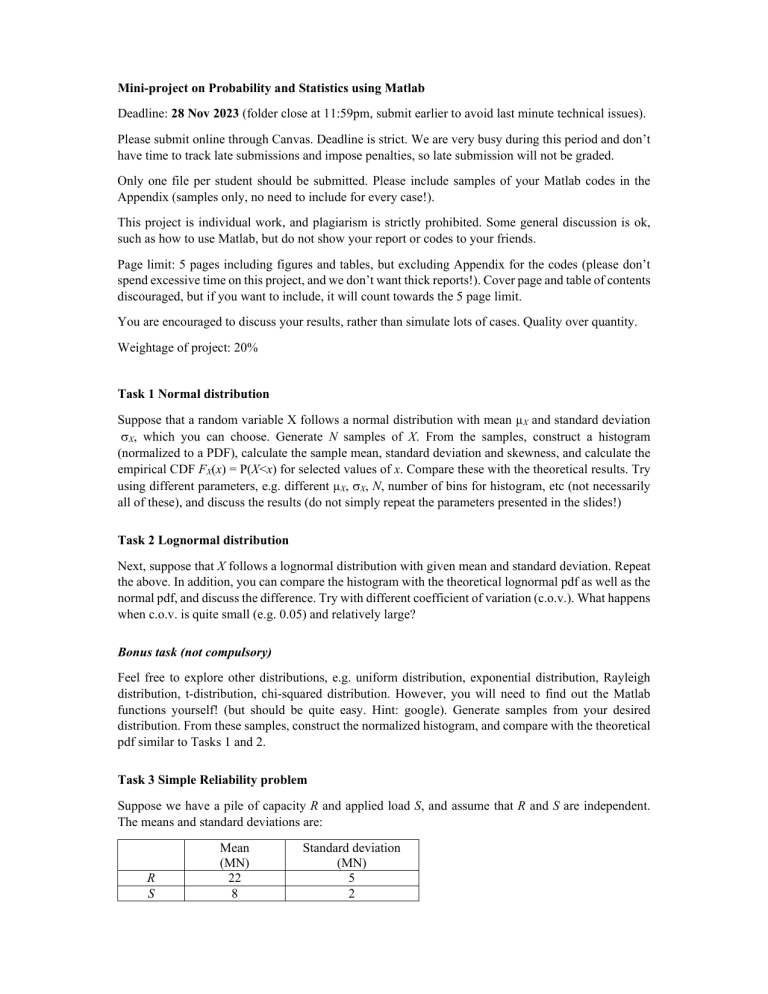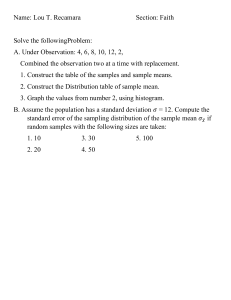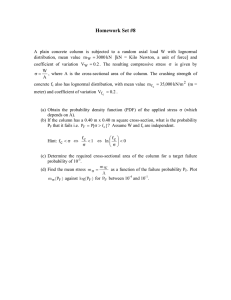
Mini-project on Probability and Statistics using Matlab Deadline: 28 Nov 2023 (folder close at 11:59pm, submit earlier to avoid last minute technical issues). Please submit online through Canvas. Deadline is strict. We are very busy during this period and don’t have time to track late submissions and impose penalties, so late submission will not be graded. Only one file per student should be submitted. Please include samples of your Matlab codes in the Appendix (samples only, no need to include for every case!). This project is individual work, and plagiarism is strictly prohibited. Some general discussion is ok, such as how to use Matlab, but do not show your report or codes to your friends. Page limit: 5 pages including figures and tables, but excluding Appendix for the codes (please don’t spend excessive time on this project, and we don’t want thick reports!). Cover page and table of contents discouraged, but if you want to include, it will count towards the 5 page limit. You are encouraged to discuss your results, rather than simulate lots of cases. Quality over quantity. Weightage of project: 20% Task 1 Normal distribution Suppose that a random variable X follows a normal distribution with mean µX and standard deviation X, which you can choose. Generate N samples of X. From the samples, construct a histogram (normalized to a PDF), calculate the sample mean, standard deviation and skewness, and calculate the empirical CDF FX(x) = P(X<x) for selected values of x. Compare these with the theoretical results. Try using different parameters, e.g. different µX, X, N, number of bins for histogram, etc (not necessarily all of these), and discuss the results (do not simply repeat the parameters presented in the slides!) Task 2 Lognormal distribution Next, suppose that X follows a lognormal distribution with given mean and standard deviation. Repeat the above. In addition, you can compare the histogram with the theoretical lognormal pdf as well as the normal pdf, and discuss the difference. Try with different coefficient of variation (c.o.v.). What happens when c.o.v. is quite small (e.g. 0.05) and relatively large? Bonus task (not compulsory) Feel free to explore other distributions, e.g. uniform distribution, exponential distribution, Rayleigh distribution, t-distribution, chi-squared distribution. However, you will need to find out the Matlab functions yourself! (but should be quite easy. Hint: google). Generate samples from your desired distribution. From these samples, construct the normalized histogram, and compare with the theoretical pdf similar to Tasks 1 and 2. Task 3 Simple Reliability problem Suppose we have a pile of capacity R and applied load S, and assume that R and S are independent. The means and standard deviations are: R S Mean (MN) 22 8 Standard deviation (MN) 5 2 Probability of failure pF is defined as pF = P(R – S < 0) -------Eq. (1) or equivalently pF = P(R/S < 1) -------Eq. (2) Using Monte Carlo Simulation, estimate pF for 3 cases. For each case, the distribution type for R and S are specified in the following table. R Normal distribution Lognormal distribution Normal distribution Case 1 Case 2 Case 3 S Normal distribution Lognormal distribution Lognormal distribution How does the choice of distribution type affects pF ? Optional: For Case 1 and Case 2, it is possible to calculate pF theoretically. Hint: for Case 1, use Eq. (1). For Case 2, use Eq. (2). Compare with the simulation results. This task is optional but will be very helpful for your exam preparation! Task 4 More “complex” reliability problem A cantilever beam is subjected to a point load as shown below. The displacement at the tip is PA2 (3L A) 6 EI The cross-section is a circular hollow cylinder with diameter D and thickness T. The second moment of area, I is I D4 ( D 2T )4 64 A D T L The random variables are P, A, L, E, D, T. Assume that they are all statistically independent, and normally distributed, with a coefficient of variation of 0.06. The mean values are provided in the following table. Assume that failure occurs if the displacement > 0.03m. Using Monte Carlo Simulation, determine the probability of failure. D (m) T (m) P (N) A (m) L (m) E (N/m2) 1800 4 8 0.2 0.01 2 1011 Bons tasks (really not necessary, for students with a lot of time and are bored) Change distribution types and coefficient of variation for some variables. Try and make some variables correlated (only for advanced Matlab users, need to find out yourself how to generate correlated variables!




